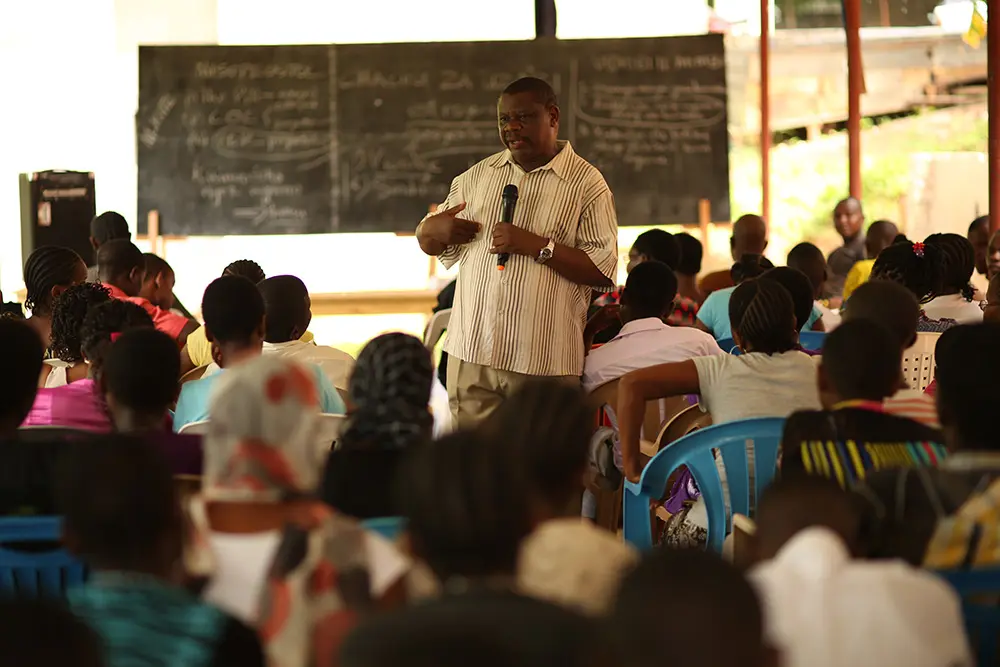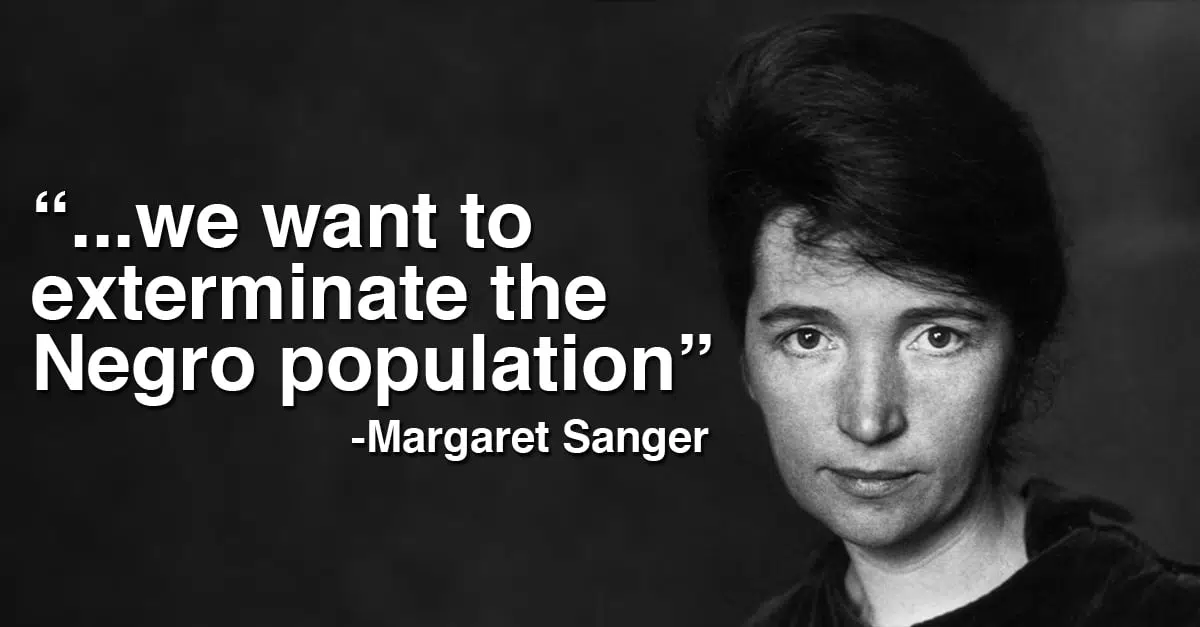If any single age really attains, by eugenics and scientific education, the power to make its descendants what it pleases, all men who live after are the patients of that power, slaves to the dead hand of the great planners and conditioners. If man chooses to treat himself as raw material, raw material he will be. – C.S. Lewis, The Abolition of Man.1
What is Eugenics?
In order to be able to understand and discuss the eugenics mentality and its goals, it is necessary to define the general categories of eugenics practice. Unfortunately, there is more than one form of eugenics.
Eugenics in general is the planned or selective breeding of human beings, with the objective of eventually altering the genetic makeup of future generations. The word “eugenics” (well-born) is derived from the Greek eu, (“good” or “well”) and genos (“race” or “stock”). Eugenics determines who may reproduce and who should be left behind, and it makes these determinations based on hereditary, physical or mental characteristics. Prospective parents who have “undesirable” qualities are left behind.

A 1930’s poster of the Eugenics Society, courtesy of Wellcome Library (CC BY 4.0)
Positive Eugenics vs. Negative Eugenics
Positive eugenics is the preferential breeding of so-called “superior” individuals in order to genetically improve the stock of the human race. The most famous example of positive eugenics is the Nazi Lebensborn (“Fount of Life”) program, with the objective of breeding a blond, blue-eyed master race.2
Since negative eugenics is much simpler to employ and is much easier to cover up than positive eugenics, it comprises the overwhelming majority of current eugenics practice. It consists of the discouragement or the legal prohibition of reproduction of individuals carrying genes leading to disease or disability. This can be achieved by genetic counseling or by sterilization, either voluntary or enforced. Of course, abortion and euthanasia are also popular means of eliminating the “defective.”
One bizarre practice that has recently cropped up might be referred to as “reverse eugenics” – the act of deliberately undergoing genetic testing in order to bear children who have specific birth defects, such as profound deafness. Perhaps this could be referred to as “kakosgenics,” or “bad birth,” from the Greek.

The Eugenic Record Office’s 1912 Field Worker’s Conference
“Reverse eugenics” is perhaps the ultimate expression of the reduction of children to a product or possession that may be created with certain specifications. Thankfully, this practice is still rare. The most notorious example is the case of deaf lesbians Candace A. McCullough and Sharon M. Duchesneau, who used the “services” of a deaf sperm donor to have a son, Gauvin, who is also deaf, in 2001. Duchesneau enthused that, “A hearing baby would be a blessing. A deaf baby would be a special blessing.” We wonder what Gauvin, who is now a teenager, thinks of all of this as he faces unnecessarily inflicted struggles in life just because his narcissistic “parents” wanted him to be like them.3
A Brief History of Eugenics
Eugenics was a well-established and respected science from the late 1800s until World War II, when it fell out of favor due to well-publicized Nazi atrocities. The idea was popularized by the scientist Francis Galton in the 1800s, and it reached new heights during WWII where the Nazi eugenics programs exterminated millions. Distinguished scientists and professors published dozens of textbooks on the topic, and many of the leading thinkers of the day studied human hereditary in order to “preserve the purity” and the health of the White race.
At the time, this was considered mainstream thinking among the elite. However, there is ample evidence that most average people did not subscribe to the eugenics philosophy, which has always been deeply and terminally racist. Books with titles like The Rising Tide of Color Against White World-Supremacy, Christianity and the Race Problem, Parenthood and Race Culture, and Racial Hygiene: A Practical Discussion of Eugenics and Race Culture crowded bookstore shelves and achieved a great popular appeal, selling millions of copies to both scholars and people from all walks of life.4
In fact, it was possible in some nations to undergo a lengthy and rigorous course of study leading to a doctorate in eugenics.
Some of the more honest pro-abortion theorists have observed that it is always wealthy white people who drive the movement to exterminate those they consider imperfect – and many times, dark skin is considered an “imperfection.” The “lineup” of the most famous eugenicists in America and Great Britain shows that almost every single one was – or is – white and wealthy. Two of these are well-known to the pro-life movement: Margaret Sanger, founder of the American Birth Control League (later the International Planned Parenthood Federation) and Marie Carmichael Stopes, founder of the Society for Constructive Birth Control and Racial Progress, and for whom the population control organization Marie Stopes International is named.

Marie Stopes in her laboratory
As radical feminist Ninia Baehr has observed, “Historically, white, heterosexual, able-bodied, middle-class men and women in the population control, birth control, eugenics, and abortion rights movements have not respected the choices of people who were different from them.”5
Another primary motivation behind early 20th-Century eugenics was efficiency in the form of cost-cutting. This was always carried out at the expense of the poor and disadvantaged. Supreme Court Associate Justice Oliver Wendell Holmes stated famously that “We have seen more than once that the public welfare may call upon the best citizens for their lives [in warfare]. It would be strange if it could not call upon those who already sap the strength of the State for these lesser sacrifices…. Three generations of imbeciles are enough.”6
Eugenics Rebranded for a Modern Era
Due to its deservedly filthy reputation, eugenics has now been rebranded as “human genetics.” Eugenics organizations that existed during the horrors of Nazi Germany have renamed themselves. For example, the $70 million-dollar-a-year population suppression organization EngenderHealth was called the Sterilization League for Human Betterment during World War II, and the Society for the Study of Social Biology was at one time known as the American Eugenics Society. However, no matter how much camouflage is applied, eugenics lives on, and its principles thrive – in more socially acceptable, if still lethal, forms.
The majority of followers of what we call the “culture of death” indeed disavow the word “eugenics,” but not its philosophies and practices. They fight for population control under the guise of “reproductive choice,” sex-selection abortions, prenatal testing followed by the abortion or passive infanticide of handicapped preborn children and newborns. They promote in-vitro fertilization and all kinds of other assisted reproduction techniques, fetal experimentation and organ harvesting, cloning, euthanasia and even transhumanism. They also support the deliberate building of high-volume abortion mills in minority neighborhoods and spread the scourge of euthanasia, which is directed at the elderly and handicapped. “Developed” nations direct the majority of their population control spending towards Africa.
All of these practices are eugenic in nature, because they “select out” weaker and those the elite consider less desirable through artificial selection.

Emil Hagamu, regional director for Human Life International, has spent over 20 years combating efforts to suppress fertility and undermine families in East Africa.
The theory of eugenics is the purest distillation of anti-life thinking. The practice of eugenics is simply the practical aspects of the various anti-life movements in action. Eugenics covers the entire spectrum of the “slippery slope,” from artificial contraception to abortion to euthanasia to genocide and encompasses many other evils as well.
Eugenicists still tirelessly research the most efficient methods for eliminating the “unwanted” and unfit. Both on the individual and personal scales, prenatal diagnosis and abortion are the ideal tools for eliminating the less-than-perfect. In the United States, the National Institute of Health (NIH) has found that parents abort more than 95% of all preborn babies who are found “defective” by prenatal genetic tests.7
In China, India and other Asian countries, of tens of millions of preborn babies have died from abortion – not because they were handicapped, but because they were female.
In summary, eugenics is the foundation for “scientific racism.” It is the driving force behind abortion, euthanasia, embryonic and fetal research, the global population policy, and a galaxy of other evils. Unfortunately, the philosophy of eugenics is ingrained in all of the social sciences, including anthropology, sociology, and psychology. Since it is so pervasive, it is certainly worth studying and understanding.
The Eugenics Philosophy Today
From Nazi Germany to the mid-1980s, eugenics practice limited itself to dictating that we, not God, will determine who will be born into this world (through the widespread practice of abortion). We are now at the point where eugenics may very well determine who will remain here (through the growing practices of infanticide, euthanasia, “medicide” and “senicide”).
Eugenics certainly did not die with the Third Reich. The eugenics “movement” flourished long before Hitler came to power, and it is certainly alive and well today. In fact, it is stronger now than it ever has been. And, since its adherents have learned their lessons regarding the value of the tactics of stealth, deception, incrementalism, and propaganda from long experience, the eugenics movement is far deadlier.
The Rise of Eugenic Abortions
Public health suffers when immoral practices – such as abortion and eugenics – run rampant. Today, we can see how the eugenic beginnings of Planned Parenthood permeate society.
Margaret Sanger, the Founder of Planned Parenthood, desired to exterminate African Americans:
We do not want word to go out that we want to exterminate the Negro population and the minister is the man who can straighten out that idea if it ever occurs to any of their more rebellious members. – Letter from Margaret Sanger to Dr. C.J. Gamble, December 10th, 1939
Sanger also aligned herself with the KKK. Given this history, it is consistent that, today, black women receive more abortions than any other race, and that more black children are aborted in NYC than born.
Abortion is increasingly used for eugenic reasons, such as sex selection or birth defects. Abortion disproportionately affects individuals with disabilities. An estimated 60-90% of all preborn children diagnosed with Down syndrome are aborted. The misconceptions surrounding individuals with Down syndrome contribute to this high rate.
And those who think this is a good thing don’t hold back. Jocelyn Elders, the Surgeon General during the Clinton Administration, said in her 1990 testimony to the US Senate:
Abortion has had a positive, public-health effect (because it has reduced) the number of children afflicted with severe defects. … The number of Down syndrome infants in Washington state in 1976 was 64% lower than it would have been without legal abortion.
More recently, Michael Hugo, the former Democratic Committee Chair of Framingham, MA’s City Council, expressed concerns in early 2023 about whether a sonographer would “miss” a birth defect in an ultrasound. His concern was centered around how much children with birth defects would cost taxpayers! He would rather see them killed.
Infanticide
Children who are born alive during an abortion attempt are at risk of being killed – or neglected and left to die – shortly after. Many pro-abortion sources say that “born-alive abortions” do not exist. Minnesota’s 2018 Report to the Legislature would disagree:
- In one instance, APGAR score was 1/1. No measures were taken [sic] and the infant did not survive.
- In one instance, comfort care measures were provided as planned and the infant did not survive.
- In one instance, no specific steps taken to preserve life were reported and the infant did not survive.
Jill Stanek, formerly a registered nurse in the Labor and Delivery Department at Christ Hospital in Illinois, testified before the House Judiciary Committee about how children born alive after an abortion attempt were killed:
I discovered babies were being aborted alive and shelved to die in the department’s soiled utility closet.” Her testimony told various stories of children being born and discarded like waste while still alive. “I was traumatized and changed forever by my experience of holding a little abortion survivor for 45 minutes until he died, a 21/22-week-old baby who had been aborted because he had Down syndrome.
And the practice is not limited to the US. Abortion survival (and the subsequent infanticide) occurs even in “progressive” Europe:
In the Netherlands the situation is even worse: after 24 weeks, in cases of serious malformation, not only is abortion possible but so is infanticide. The majority of these countries do not give any information on these events. It is very difficult to obtain precise data because these States rarely acknowledge this situation let alone provide information. […] These children are frequently abandoned without care, put aside in an empty room or closet, where they struggle to breathe, sometimes injured by the abortion, before dying alone. … According to witness testimonies, some may be asphyxiated or thrown away with waste despite signs of life. In other words, these newborns are killed or left to die, even though in another room, doctors try to save premature babies of the same gestational age.
(If you want to learn more, click here to read the testimonies of medical staff who witnessed these horrors. Their stories begin on page 12.)
Population Control
An additional concern is that developed nations actively limit the fertility rate of developing nations. The Kissinger Report (NSSM-200) is a stark example of this reality. This declassified document reveals how the State Department charted a path to limit fertility in developing nations (specifically naming 13). The goals of NSSM-200 included maintaining the US’ global hegemony, granting the US better access to natural resources in the developing nations, and limiting the number of anti-imperialistic youth in developing nations who might grow up to challenge U.S. power.
NSSM-200 outlines coercive methods to convince individuals to be sterilized. Such methods include withholding food or aid and offering financial incentives to sterilize. The practice of forced sterilization is practiced by the “educated” and “enlightened” developed nations, who insist on using third-world countries as their guinea pigs. We see such practices in other areas as well. The worryingly increasing trend of transhumanism, euthanasia, or genetic technologies like gene editing or selection, charts a stark future where those “less desirable” suffer the consequences of being “inferior.”
One method of gene editing is called “germline editing,” which is a way to edit a preborn baby’s genes in a way that would make the changes hereditary. In other words, germline editing changes the makeup of a baby and risks that the baby’s future children will also inherit the changes. Germline editing is done at the earliest stages of development. As this is a newer technology, we don’t know yet the long-term effects on health or posterity.
Should this become widely available and practiced, we step into a future where children are used as commodities. We risk a society where children are edited according to the parent’s wishes, without regard to the good of the child, and where “imperfect” children are treated as garbage, or “lesser than” those who underwent germline editing.
An example of gene editing occurred in 2018. A Chinese scientist announced that twin girls conceived via IVF had successfully been genetically altered to resist smallpox, malaria, and HIV.
There is no question whether these technologies are eugenic in nature.
Euthanasia
The recent push for legal euthanasia, as seen in the Netherlands and Canada, is another disturbing result of eugenic theory.
Killing off the elderly or suffering through euthanasia because they are an “inconvenience” is reprehensible. People deserve care, support, and comfort in their final days. True palliative care suffers under euthanasia. When euthanasia is not only legal but encouraged, hospitals don’t have an incentive to keep a patient alive who may need extra care or who is costing them money. Humans are not inconveniences that can be thrown away at will.
Take, for example, Richard Leskun and his wife, Marilynn. Richard alleges that Marilynn was in the hospital following a fall, and medical staff kept pushing Richard to allow them to perform euthanasia. They would wear him down, come to him when he was tired, and take advantage of the fact that he was weakened to try to pressure him. He persisted. But once it was clear that his wife was dying, he agreed to a DNR order. To his horror, they had already placed a DNR order without his consent.
Another example of pressured euthanasia is the story of Candice Lewis, a woman with cerebral palsy and spina bifida. Candice went to the ER in Newfoundland in 2016. Her mother alleges that she was told to consider euthanasia and that it would be “selfish” to not pursue it. Her mother refused, and a year later, Candice was back doing her hobbies, very much alive.
Alan Nichols was a Canadian who suffered from depression. Despite his not showing any signs of imminent death, he was killed via euthanasia (also referred to as “MAiD” in Canada). His family is still looking for answers. They say that Alan was not fit to make the decision to proceed with MAiD given his mental health history.
Discrimination against People with Disabilities
Eliminating “undesirable” traits through human “enhancement” (including killing any unborn child who may possess “undesirable” qualities) is sometimes referred to as “new eugenics,” though there is nothing new about seeking to eliminate the “inferior.”

Logo of the Third International Eugenics Conference (1932), courtesy of Welcome Collection
Those with disabilities are rightly concerned about such practices. According to the UN Special Rapporteur on the Rights of Persons with Disabilities, Catalina Devandas:
If assisted dying is made available for persons with health conditions or impairments, but who are not terminally ill, a social assumption could be made that it is better to be dead than to live with a disability. […] What we need is a profound cultural transformation on the way [sic] society relates to the difference. That is a commitment to embrace disability as a positive aspect of human diversity. States must combat all forms of discrimination based on disability.
This fear outlines specifically the dangers of the “slippery slope” of accepted (and even encouraged) euthanasia.
If anyone thinks these fears are far-fetched, they need only to recall how easily and quickly the Nazis rose to power and justified the Holocaust.
The Takeaways
Concern for eugenics or public health cannot justify any murder, even if commanded by public authority. CCC 2268
Eugenic policies are highly morally problematic. If we are to accept that some people are superior to others, and that “inferior” individuals should die out (or be killed), we cannot be surprised if something akin to the Holocaust happens again. Who are we to judge who is inferior and deserves death?
It makes no sense, in the pursuit of “public health, concerns,” to kill off “unworthy” individuals. Murder itself is a public health concern. While the desire to eradicate disease is commendable, the ends never justify the means. A pro-eugenicist may say that the practice saves future people from suffering hereditary diseases. But a hard life does not equal a bad one, or a wasted one. And we don’t get to determine who is “worthy” enough to have a family.
This practice may not remain rare, as new “rights” are invented out of thin air on nearly a daily basis. As C.S. Lewis observed, we are indeed becoming “raw material” to be molded into an image believed to be perfect–but far from God.
+ Endnotes
[1] C.S. Lewis. The Abolition of Man. Quoted in “Controllers and Conditioners: The Abolition of Man.” BreakPoint with Charles Colson, October 11, 2001.
[2] David Crossland. “Nazi Program to Breed Master Race: Lebensborn Children Break Silence.” Der Spiegel, November 7, 2006.
[3] One example of this practice involves using sperm donors to have children who are profoundly deaf, so that they may share in so-called “deaf culture” [Darshak M. Sanghavi, M.D. “Wanting Babies Like Themselves, some Parents Choose Genetic Defects.” Health, December 5, 2006; Amos Zeeberg. “Reverse Eugenics?” Discover, December 6, 2006].
[4] Lothrop Stoddard. The Rising Tide of Color Against White World-Supremacy [New York City: Charles Scribner’s Sons], 1921; J.H. Oldham. Christianity and the Race Problem [New York City: George H. Doran Company], 1918; Caleb Williams Saleeby. Parenthood and Race Culture: An Outline of Eugenics [New York City: Moffat, Yard and Company], 1911; Thurman B. Rice. Racial Hygiene: A Practical Discussion of Eugenics and Race Culture [New York: The MacMillan Company], 1929.
[5] Ninia Baehr. Abortion Without Apology: A Radical History for the 1990s [Boston: South End Press], 1990, see especially pages 33, 47, and 56. Leftist theorist Alexander Cockburn observed that “The not-so-concealed theme of some major figures in NARAL [National Abortion Rights Action League] and NOW [National Organization for Women] was that abortion should be legal because the most prolific breeders were welfare mothers from the dangerous classes … the leader of NARAL in New York lobbied against the provisions to protect poor minority women from involuntary sterilization, and so did Planned Parenthood” [Alexander Cockburn, quoted in Proletarian Revolution, Fall 1989, page 28].
[6] United States Supreme Court decision Buck v. Bell, 274 US 200 (1927), at 207.
[7] As described in Bobby Schindler. “Yes, We Have a Culture of Death.” LifeNews, September 23, 2014. This practice has been consistent for decades. See Sorenson, “Some Social and Psychological Issues in Genetic Screening.” Symposium on Intrauterine Diagnosis (D. Bergsma, editor). 1971, page 177.
















